Last Updated on April 20, 2024 by Amin Tawar
Megalodon Length
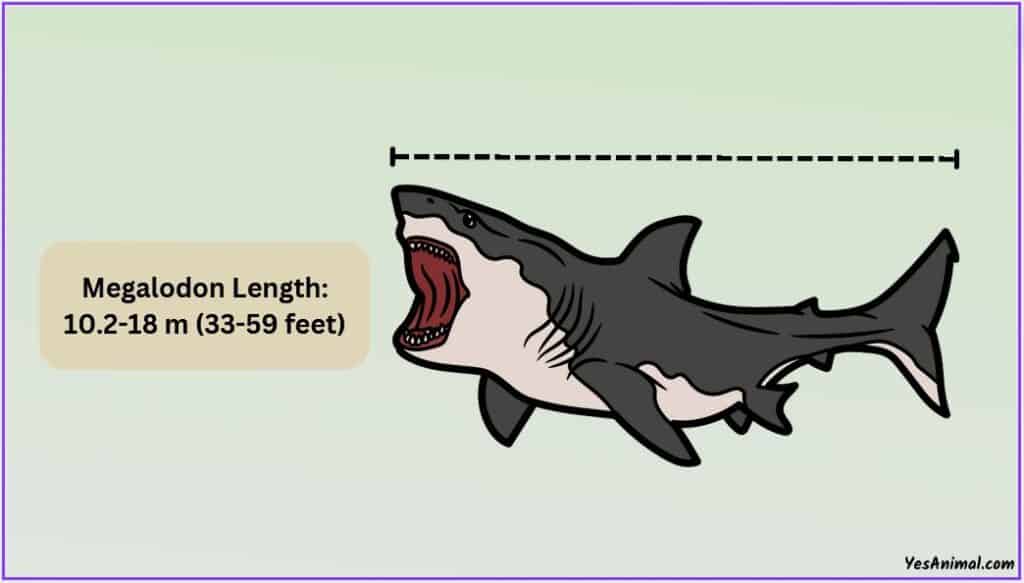
Although megalodon is often depicted as a monstrous creature in popular culture, much of what we know about this species comes from fossilized teeth and other fragments that have been found.
It is currently thought to be extinct, and the exact size and appearance of the species are still the subject of scientific debate and speculation.
To be more clear, Megalodon was a species of shark that lived millions of years ago during the Cenozoic Era.
It is considered to be one of the largest and most powerful predatory sharks to have ever lived, with some estimates suggesting that it could have reached average lengths of up to 10.2-18 meters (about 33-59 feet) and a maximum length of 20 meters (66 ft).
Megalodon had a massive, streamlined body with a pointed snout, large teeth, and powerful jaws. It is thought to have preyed on a variety of large marine animals, including whales and dolphins.
| Megalodon | Meter | Feet |
| Average length | 10.2-18 meters | 33.5-59 feet |
| Maximum length | 20 meters | 66 feet |
Megalodon Weight
Similar to their length, it is challenging to precisely estimate a species’ weight based on the scant fossil evidence, and various techniques and suppositions can result in different weight estimates.
Others have used more indirect techniques, like comparing the size of megalodon teeth to those of contemporary shark species. Some studies have used computer models and scaling techniques to estimate the weight of a megalodon based on its size and other physical characteristics.
Despite the challenges, several studies show that the average size of the Megalodons is about 30 metric tons (1 metric ton = 1,000 kg; about 66,000 pounds) and can reach up to more than 65 metric tons (about 143,000 pounds). 1
| Megalodon | Metric tons/Kilograms | Pounds |
| Average weight | 30 metric tons (1 metric ton = 1,000 kg) | 66,000 pounds |
| Maximum weight | 65 metric tons | 143,000 pounds |
Megalodon Tooth & Jaw Size
Megalodons are known for their massive size and powerful jaws, and their teeth are among the largest of any known shark species. Megalodon teeth can reach lengths of up to 7 inches (18 centimeters), with some of the largest specimens measuring over 10 inches (25 centimeters) in length.
The teeth of megalodons were triangular in shape and serrated, which would have allowed them to effectively cut through the tough flesh of their prey.
In terms of jaw size, megalodon is thought to have a massive, powerful jaw that was capable of exerting tremendous force. Some estimates suggest that the jaws of the megalodon could have reached lengths of up to 12 feet (3.7 meters), and the animal is believed to have had a bite force of up to 18 tons (16 metric tons).
Megalodon Size Compared To Human
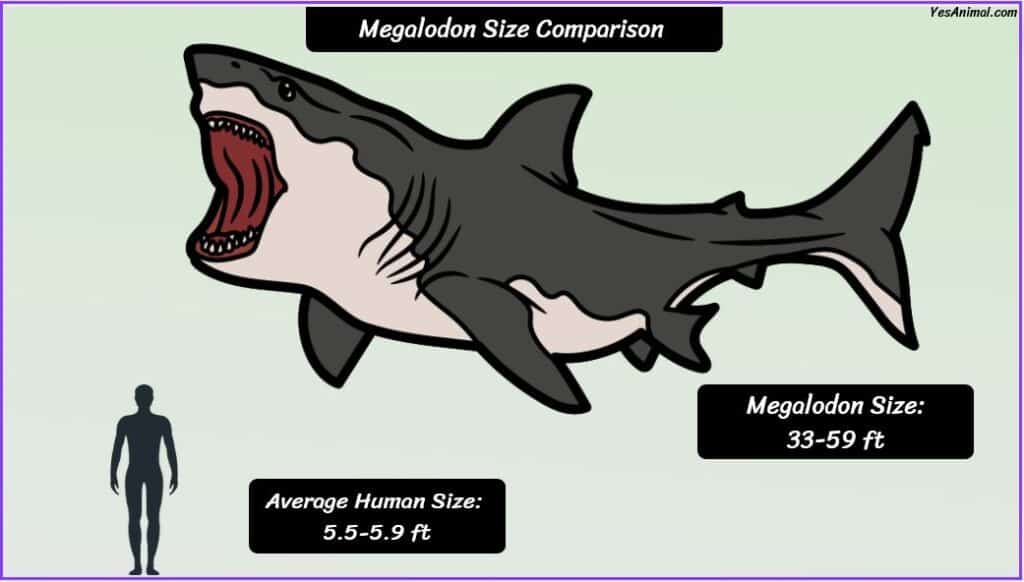
Megalodons have lived long back and are considered to be extinct just like the dinosaur and the dodo, and it is quite difficult to visualize and imagine how large or small they would have been. To make a fair assumption of their size, we can compare them with known species like us.
Megalodons are considered to be one of the largest and most powerful predatory sharks to have ever lived, with some estimates suggesting that they could have reached lengths of up to 60 feet (18 meters) or more.
In comparison, the average height for a human female is around 5.5 to 5.9 feet and the average weight is about 132 to 176 pounds (60 to 80 kgs). This means that the megalodon was significantly larger than a human in terms of length and weight.
| Animal type | Length | Weight |
| Megalodon | 10.2-18 meters (33-59 feet) | 30 metric tons (1 metric ton = 1,000 kg; about 66,000 pounds) |
| Average adult human | 5.5 to 5.9 feet | 132 to 176 pounds (60 to 80 kgs) |
Also Check Out Our Guide On Other Shark Sizes
Megalodon Size Comparison With Blue Whale
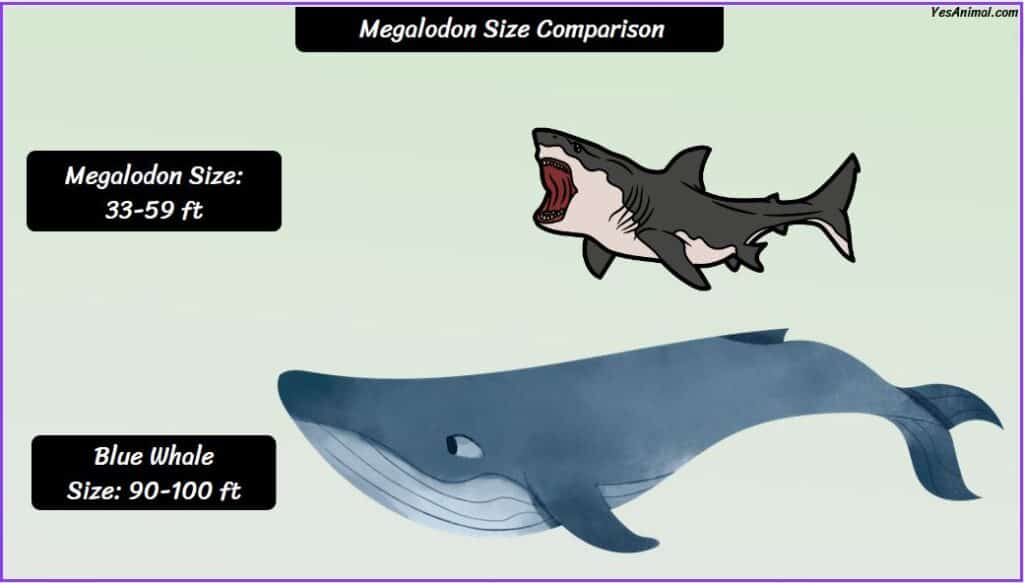
Currently Blue whales are the largest animal on earth, considering this it would be quite interesting to see how large or small this largest animal is in comparison to the Megalodons.
Megalodons are considered to be one of the largest and most powerful predatory sharks to have ever lived, with some estimates suggesting that they could have reached lengths of up to 60 feet (18 meters) or more and weight of 30 metric tons (1 metric ton = 1,000 kg; about 66,000 pounds).
In contrast, the Blue whale measured up to 100 feet (30 meters) long and 400,000 pounds (200 tons) heavy. Based on this, blue whales are significantly larger than megalodon in terms of both length and weight.
| Animal type | Length | Weight |
| Megalodon | 10.2-18 meters (33-59 feet) | 30 metric tons (1 metric ton = 1,000 kg; about 66,000 pounds) |
| Blue whale | 100 feet (30 meters) | 400,000 pounds (200 tons) |
Megalodon Size Comparison To Great White Shark
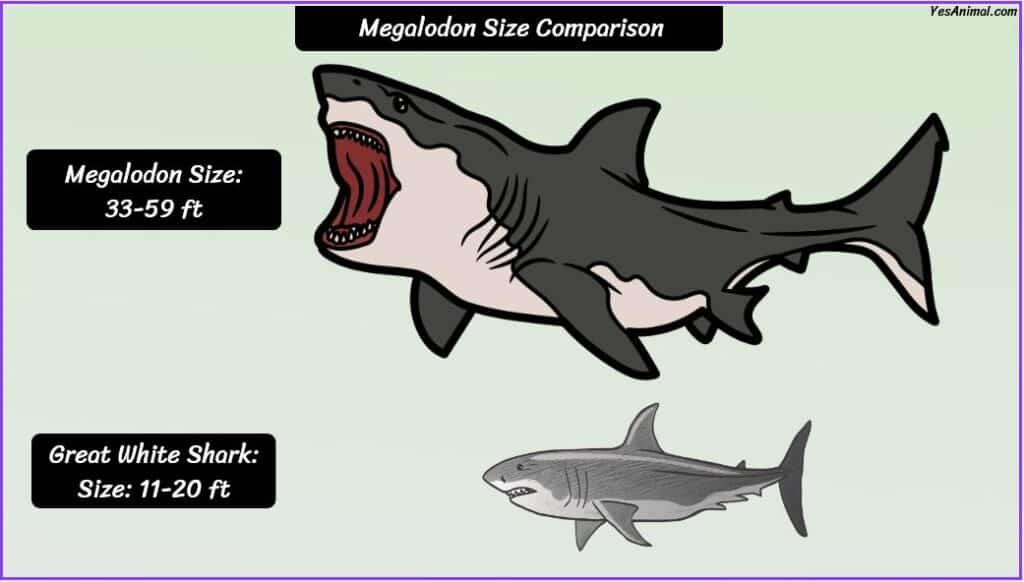
If we compare the Great white shark with one of the largest extinct species, the Megalodon, we would see that the Megalodon is much larger.
Nonetheless, Megalodon, which lived approximately 23 to 3.6 million years ago, was a massive predatory shark that is believed to have been significantly larger than any shark species that exists today.
Estimates of megalodon’s size vary, but it is generally thought to have been up to 10.2 meters (about 33.5 feet) long and weigh several hundred tons.
In comparison, adult great white sharks typically grow to be about 15-20 feet (4.5-6 meters) long and weigh around 30 metric tons (1 metric ton = 1,000 kg; about 66,000 pounds).
While it is difficult to accurately compare the size of extinct species to modern ones, it is clear that the megalodon was much larger than the great white shark.
| Animal type | Length | Weight |
| Megalodon | 10.2-18 meters (33-59 feet) | 30 metric tons (1 metric ton = 1,000 kg; about 66,000 pounds) |
| Great white shark | 11-20 feet (3.3-6 meters) | 680 and 1,800 kg (1,500 and 4,000 pounds) |
Megalodon Size Compared To Orca
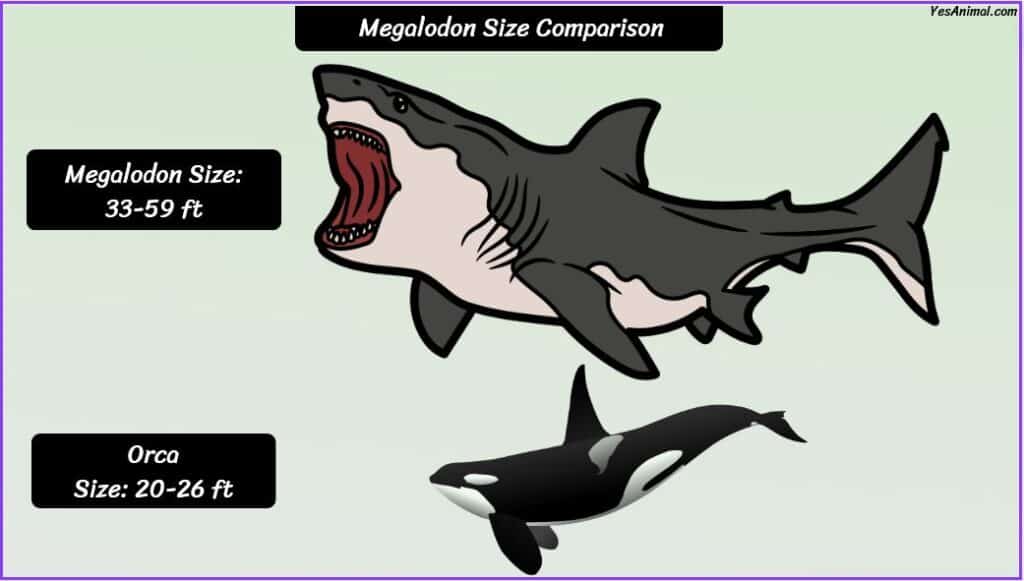
Moving on, let’s see how different the Orca is in terms of its size when compared to the Megalodon. Orcas, also known as killer whales, are a species of cetacean that belong to the dolphin family.
They are a large species, with adult males reaching lengths of up to 32 feet (9.8 meters) and weighing up to 22,000 pounds (10,000 kilograms). Female orcas are slightly smaller, reaching lengths of up to 28 feet (8.5 meters) and weighing up to 12,000 pounds (5,400 kilograms).
On the other hand, the Megalodons are about 10.2 meters (about 33.5 feet) in length and 6 metric tons (13,000 pounds) in weight. Overall, the Megalodon was significantly larger than orcas, with some estimates suggesting that it could have been almost twice as long as an adult male orca.
| Animal type | Length | Weight |
| Megalodon | 10.2-18 meters (33-59 feet) | 30 metric tons (1 metric ton = 1,000 kg; about 66,000 pounds) |
| Orcas | 6 to 8 meters (20 to 26 ft) | 6 metric tons (13,000 pounds) |
Megalodon Size Comparison To Bus & Titanic
In comparison to the prehistoric gigantic Megalodon, an average school bus is around 40 feet (12 meters) long and a typical double-decker bus is around 50 feet (15 meters) long and 10,000 to 25,000 pounds heavy.
The Titanic, on the other hand, was about 882.5 feet (269 meters) long and weighed around 46,000 tons. So, Megalodon was significantly larger than a bus and much, much larger than the Titanic.
| Animal type | Length | Weight |
| Megalodon | 10.2-18 meters (33-59 feet) | 30 metric tons (1 metric ton = 1,000 kg; about 66,000 pounds) |
| Bus | 50 feet (15 meters) | 10,000 to 25,000 pounds |
| Titanic | 882.5 feet (269 meters) | 46,000 tons |
Conclusion
And that was everything you need to know about the size of megalodon. I hope this article was informative enough and your queries were answered.
Thank You For Reading!
Related Articles You May Like